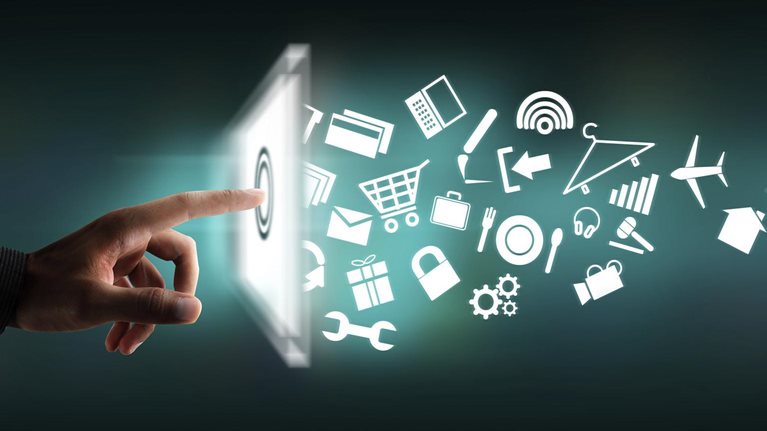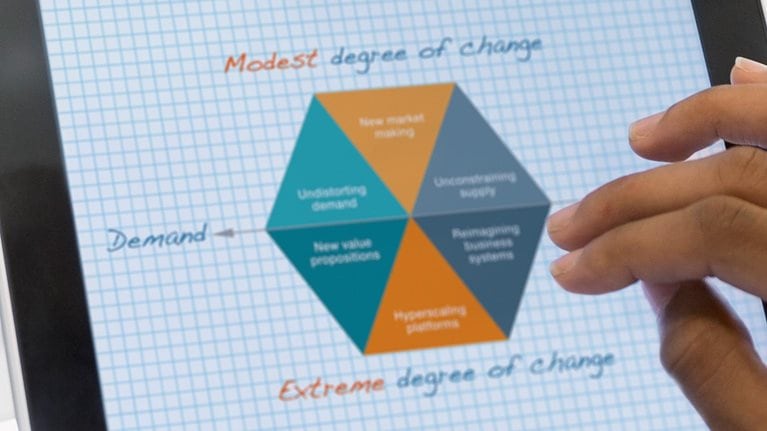Which country leads the world in digital? Many might be tempted to answer that the US does, but the answer actually depends on what aspect of “digital” you’re looking at. When it comes to Internet penetration, the US has much higher rates than in the EU, 88 percent compared with 71 percent.1 But dig a little deeper and the picture changes.
Where Europe has the edge
When it comes to customer preferences for digital channels, Europe is way ahead. Recent McKinsey research examined the digital customer experience in the mobile telecom sector and found that European customers are more open to digital services than their US counterparts. Almost half of them would be happy to manage their relationships with providers entirely through digital channels, for instance, compared with fewer than a third of customers in the US.2 In both sales and customer care, levels of awareness and usage of self-serve digital channels (such as mobile apps) and live digital channels (such as web chat) are already markedly higher in Europe than in the US (exhibit).

Similarly, European banking customers are more likely than Americans to prefer digital to physical channels. Another recent McKinsey survey found that 58 percent of Western Europeans (and a hefty 85 percent of Northern Europeans) prefer digital to branch-based transactions, as against only 52 percent of US customers. That’s despite the fact that digital banking has higher penetration in the US (at 73 percent) than in Western Europe (60 percent).3
The European digital edge seems to extend to other categories too: 24 percent of car-insurance sales take place online in Europe, for instance, compared with 17 percent in the US; similarly, for personal loans, the shares are 27 percent and 16 percent respectively.4
Customers in Europe are much more likely to use digital channels than stores or call centers, whether they are adopting a new service, reporting technical problems, querying bills, or making admin changes, whereas US customers still prefer to use stores, and to a lesser extent call centers, for some of these needs. What’s more, European customers are more satisfied with “digital only” experiences than with wholly traditional ones, which is not true of their US counterparts.
Would you like to learn more about our Digital McKinsey Practice?
However, common ground emerged when we asked users of traditional channels what was deterring them from using digital services. Telecom customers in both regions expressed a preference for speaking to someone in person, though this sentiment was more marked in the US (three times higher than the second preferred option) than in the EU (twice as high).5
Why the difference?
Consumers tend to adjust their expectations to the offer they receive, and in industries where companies have heavily invested in digital—such as retail, with Amazon—Europe and the US both show strong penetration. In the telecom market, the differences in the pace of digital adoption can be explained by four structural differences in the markets:
1. Fragmentation, competition, and cost pressure. Europe has a more fragmented market than the US, with many smaller players, including mobile-virtual-network operators (MVNOs), engaging in fierce competition on price and costs. As price levels were forced down, telecom providers used digital channels to find savings. On the other side of the Atlantic, US companies operating on a greater scale were able to spread their fixed costs over a bigger base and did not feel the same pressure to reduce their operating costs.
2. Innovative business models. New entrants in Europe such as Free, Congstar, and GiffGaff have sought to use distinctive digital elements in their business models as a way to pull ahead of the pack. In turn, traditional operators in the EU have been forced to adjust their customer- service models and make more use of digital channels.
3. The US emphasis on physical presence. Traditional US telecom operators have focused on developing their store networks and personal service, training their customers to go to stores to buy handsets and get service. This makes it harder for them to push digital channels and handle the resulting channel conflicts. Nevertheless, omnichannel customer behavior—shifting seamlessly from one channel to another—is slightly more common in the US than in Europe: 48 percent of American customers looking for mobiles do their research online and then purchase from a store, for instance, compared with 43 percent of Europeans.
4. Dependence on physical presence for upselling and cross-selling in the US. US companies generate significant revenue from traditional channels (stores and call centers) and so are reluctant to introduce digital-only customer journeys.
Overall, the more competitive environment in European markets has produced a stronger digital offer for consumers, who are in turn more comfortable using mobile and online channels for most of their needs.
Consumers lead the way
Despite the current differences between US and EU consumers and markets, we believe that the digital development trajectory for each is likely to be much the same in the medium to long term, which means that lessons from one region can be applied to another when market forces are similar.
In the telecom industry, both EU and US companies can strengthen their position by learning from pure or more mature digital players. Almost half of European telecom customers, for example, are open to interacting with them purely by digital means, yet few are able to do so. By extending and enhancing their digital offers in e-sales and e-care, these companies could reap significant rewards in lower costs and increased customer loyalty across all segments. For US telecom companies, success will come from tailoring offers more to customer segments. For low-value segments, the prize lies in reducing cost to serve, cutting prices, and migrating customers to the cheapest channel for most journeys, i.e. digital. For millennials, moving quickly with an attractive digital offering could help telecom companies capture market share from competitors, or at least not lose it. For other segments, ensuring a seamless customer journey between channels is the key to balancing the tradeoff between omnichannel behaviors, expectations of personal interactions, and the cost advantages of digital channels.

Overcoming obstacles to digital customer care
Four steps to start winning digital consumers
In developing a distinctive digital offering, companies at almost any stage of their digital journey will find it helpful to think about four key steps:
1. Discover: shaping their digital ambition, strategy, and business case. To discover what customers really want, smart companies will segment their customer base not only by value but also by behaviors and needs across channels, thus creating a set of “personas” to which they then tailor the digital experience and customer journey. For instance, a company can ask a few questions about a particular customer’s needs before selecting which products to show them on its website. Someone looking for the latest cool product might see the three most-discussed models on social media, say, while a decisive customer in a hurry to buy might see the three products best geared to their immediate needs and price sensitivity.
2. Design: crafting a holistic digital and omnichannel approach. Customers should be able to switch between online and offline touchpoints easily and experience perfectly coordinated and rewarding multichannel journeys, such as click and collect. This is particularly important in the US, where customers prefer physical channels and personal interactions and are less open to using digital-only channels. Another helpful strategy is to embed improved live digital channels (online forums, web chat, social media) into digital self-serve channels (websites, apps, automated text messaging, virtual online agents). The option to speak to someone live if needed will overcome what customers see as the biggest barrier to using digital channels. Since most customer-care requests begin online, companies that offer customers a simple way to contact them through a digital channel will minimize the friction of changing channels, while both boosting customer satisfaction and keeping operating costs low.
3. Deliver: creating a system to rapidly deliver at scale. The key to encouraging customers to use digital channels is to adopt highly differentiated migration tactics. The best companies deliver personalized and consistent messages and offers, tailored to different customer segments at different times, as part of a campaign. Many of these offers can be sent automatically when triggered by a specific event. As an example, a customer who has just purchased a new product could be sent a link to an FAQ session on how to install it. Campaigns can also vary the messages they use according to the behaviors of different customers. For example, a company wanting to increase usage of an app might offer the same discount on the monthly subscription fee to a customer for downloading the app and using it once in the first month, and to a customer who has already downloaded the app for using it more than once every month.
4. “De-risk”: structure the program to reduce operational and financial risks. Undertaking a digital transition consumes a great deal of time, energy, and resources, and any failure can have a devastating effect. To minimize these risks, leaders develop clear and consistent governance and communications, a well-designed road map for transformation, and new incentive structures and performance metrics to facilitate cross-functional cooperation and promote a culture of flexibility and innovation. Cutting costs early can deliver quick wins and fund future changes.
While there are telling differences in consumers’ adoption of digital channels in the US and EU, it’s clear that consumer companies everywhere will need to optimize their digital and omnichannel presence. How quickly—and profitably—they do so will depend on competitive intensity, the presence of digital attackers in their particular market, and the readiness of customer segments to change their purchasing behavior.


